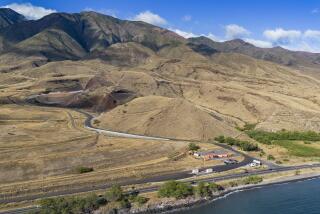Promise to Clean Land Is Buried Under Junk : Environment: Hair-care giant’s vow to clear Tuna Canyon property unfulfilled. Illegal dumping continues.
Malibu’s scenic Tuna Canyon remains strewn with trash and debris three months after hair-care giant John Paul Jones De Joria, a high-profile environmental activist, staged a publicized cleanup of his property there.
The refuse includes bags of trash left over from the cleanup De Joria organized in early summer, and provides evidence that illegal dumping has continued on the land, despite De Joria’s promise to erect barriers and take other steps to reduce the problem.
Last June, De Joria, co-founder of Paul Mitchell Systems, the large hair-care products company based in Santa Clarita, hired a crew of youths from South Los Angeles to clean up his property. The cleanup followed a Times story that contrasted the condition of his land with his reputation as a global environmentalist.
Not only do De Joria’s Paul Mitchell products tout their environmental friendliness, but De Joria has been active in promoting solar technology, rain forest preservation and other environmental projects. They include co-sponsorship of the Blue Water Festival in Malibu next Sunday, an event designed to educate the public about environmental issues and celebrate the community’s natural beauty.
Despite the flurry of cleanup activity there last summer, his own rugged property--in one of the last undeveloped coastal canyons in Southern California--remains a mess, according to the California Environmental Project, a statewide environmental group.
Scott Mathes, the group’s executive director, expressed guarded optimism about De Joria’s initial cleanup, terming it an important first step in the restoration of the majestic canyon.
But last week, after a summer of silence, Mathes lashed out at the hair-care mogul, accusing him of failing to follow through on the cleanup, and calling into question De Joria’s sincerity as an environmental activist.
“If this is the best he can do with the kind of resources he has available to him, then I don’t know what to say,” Mathes said.
De Joria, contacted in Tokyo where he is attending a convention, expressed dismay that people were again fouling the canyon. He promised to inspect it when he returns to Los Angeles at the end of the month.
Between June 23 and 27, more than 13,000 pounds of trash were removed from De Joria’s land by De Joria, his staff and the 30 workers.
But more than a dozen abandoned automobiles and thousands of pounds of litter and debris remain in the canyon, which is protected under Los Angeles County’s Coastal Plan as an “environmentally significant habitat area” and “a significant watershed.”
Moreover, signs and barriers De Joria said he would erect to deter illegal dumpers from entering fire roads and trails never materialized, the one possible exception being an abandoned van frame his workers used to block off a dirt path. Someone has since made off with the frame, leaving the area vulnerable to dumpers.
Two other dump sites De Joria said he thought had been chained off remain open.
Asked about the absence of signs prohibiting illegal dumping, De Joria said he decided against posting them, hoping the cleanup would deter dumpers. But he indicated he is ready to reconsider.
“The more fencing and the more signs we put up, the less beautiful the canyon will be, but maybe it will come to that,” he said.
Mathes said the canyon needs a systematic program of cleaning and maintenance.
On a recent walk through Tuna Canyon, Mathes pointed out several discarded cars, new homeless encampments and fresh illegal dump sites. At one location along the creek, tires and diapers shared space with an empty drum labeled “Asphalt Emulsion,” which bore the warning: “This product has not been tested or approved by the National Sanitation Foundation for contact with potable water.”
Abandoned furniture and household appliances were visible in some spots and several areas were littered with large amounts of used toilet paper. At one site, campers had erected three tents and a tepee next to the creek, a practice considered environmentally unsound because it could pollute the stream.
For all the abuse heaped on it, Tuna Canyon has been the focus of periodic cleanups by volunteers, including schoolchildren.
Earlier this year, it was scheduled to be “adopted” at a cost of $52,000 by actress Bette Midler through California Environmental Project’s “Adopt a Canyon” program, which solicits donors to pay for canyon cleanups. The plan fell through when Midler learned that De Joria, a multimillionaire, owns much of the land.
The project subsequently approached De Joria with an offer to scour the 5,000-acre canyon and place it on a monthly maintenance schedule. The offer was ignored, although De Joria later donated $800 to the group, Mathes said.
If De Joria continues to ignore the group’s proposal, since reduced to about $25,000 plus $500 per month in maintenance fees, Mathes said he will seek De Joria’s permission to let volunteers resume their efforts.
De Joria reiterated, however, that he preferred to work out a long-range plan to end the dumping rather than rely on volunteers.
Mathes dismissed such talk as foot-dragging.
“Not only is he ignoring the problem, but he’s preventing the community from assisting the canyon,” Mathes said. “If he’s got a concrete solution, great! Let’s get started.”
Meanwhile, the Santa Monica Mountains Conservancy questioned De Joria’s environmental credentials with regard to his oft-stated plans to build a golf course in the mountains between Tuna Canyon and Big Rock Mesa.
Carolyn Barr, a project analyst with the conservancy, predicted that the amount of grading required to build such a course would have a “significant impact.”
“He’s claimed it’s going to be an environmentally sensitive golf course,” she said. “Personally, I don’t think there is such a thing.”
More to Read
Sign up for Essential California
The most important California stories and recommendations in your inbox every morning.
You may occasionally receive promotional content from the Los Angeles Times.










